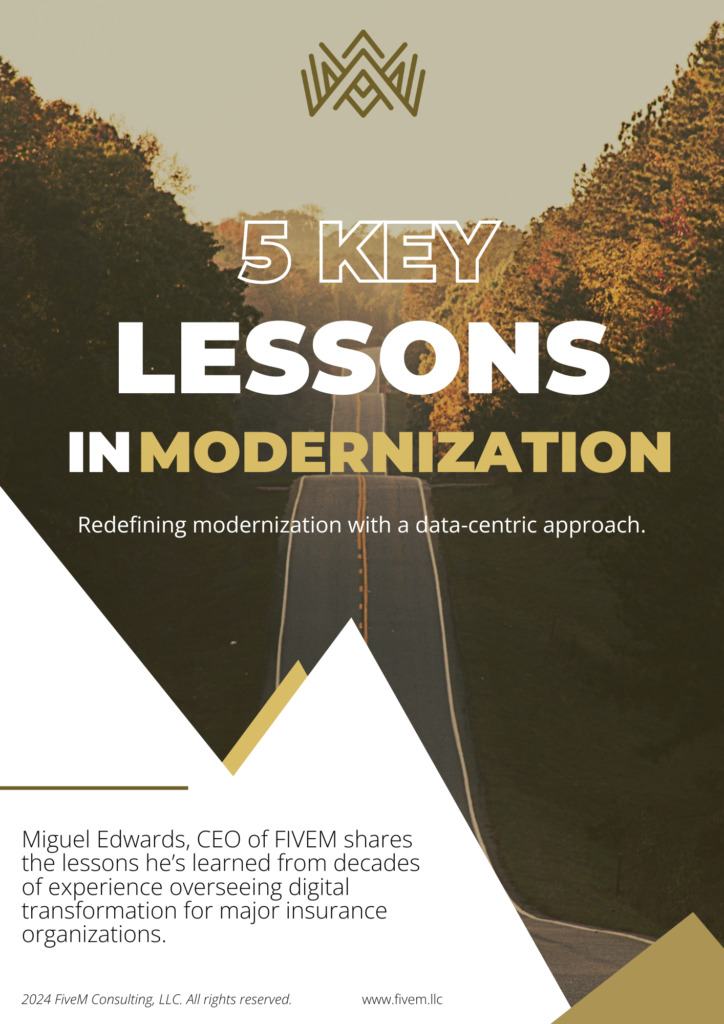In today’s insurance landscape, digital transformation is survival. Yet, when ambitious change initiatives meet the boardroom, many executives hit a wall of well-founded skepticism. It’s not that board members are out of touch; they’re cautious by design. Their role is to preserve value, manage risk, and ensure the company remains stable and compliant. Throw a multi-year digital overhaul into that mix, and it’s no wonder they ask tough questions.
But here’s the thing: digital transformation isn’t inherently risky, it’s often the safer bet compared to doing nothing. The trick is to reframe the narrative, speak the board’s language, and show how transformation aligns with what they care about most: regulatory compliance, financial stability, cybersecurity, and reputation. Let’s break down how to do exactly that.
Why the Board Is Wary and Why That’s Okay
Insurance boards are steeped in risk management. They’re tasked with guarding the company’s financial health, staying compliant with complex regulations, and maintaining trust with policyholders and regulators. And with many digital projects in the past falling short, it’s no surprise that directors are wary. They might ask blunt questions like, “Will this disrupt our agents? Could it impact our quarterly results? Are we exposing ourselves to cyber threats?”
Here’s where smart executives flip the script. Instead of pushing transformation as a tech trend, position it as a strategic move to manage existing risks more effectively. Because while staying put may feel safe, it’s often the riskiest play in a rapidly digitizing market. The reality is that insurers who don’t evolve could find themselves lagging behind faster, more efficient competitors and that’s a risk boards can’t afford to ignore.
Turning Risk Aversion into an Asset
Rather than resisting the board’s caution, use it. Frame digital transformation as the most prudent way to address looming threats and capture opportunity. One CEO of a mid-sized insurer put it best when he said, “Our legacy system worked until it didn’t.” A routine regulatory update took three months to implement, exposing them to compliance gaps. That’s not innovation, that’s liability.
When you present digital transformation as a risk mitigation strategy, you shift the board’s mindset. For example, show how upgrading systems strengthens compliance and resilience. Explain how automating manual processes reduces human error and improves auditability. If you’re investing in AI for underwriting, connect that to increased consistency, faster response times, and stronger customer experience, objectives that match the board’s strategic goals.
Also, make sure to hit the “fear of missing out” angle. Share competitive insights. Show how leading players are dedicating significant budgets toward digital initiatives. If more than half the industry is actively investing, sitting idle becomes a bigger gamble. It’s no longer a matter of “if” you should transform, it’s “how soon,” and “how smartly.”
Compliance: Not Just a Box to Check
Regulatory fear is one of the biggest hurdles in the boardroom. So meet it head-on. Don’t wait for board members to ask whether a new platform is GDPR-compliant or how it’ll affect solvency reporting—bring it up yourself. Prove you’ve baked compliance into every layer of the initiative. Involve legal and compliance teams from the outset and explain how new systems are designed with audit trails and controls in mind.
It also helps to remind the board that regulators themselves are pushing for modernization. In the EU, the Digital Operational Resilience Act (DORA) is mandating robust IT risk frameworks. In the UK, Blueprint Two is requiring firms to digitize placement and claims. When regulation nudges digital change, compliance and transformation become one and the same. Frame it that way, and you’re no longer asking the board to support something new, you’re asking them to keep pace with what’s required.
ROI: Bridging Vision and Accountability
Let’s be honest: the biggest question that stops boards from approving transformation is, “Will we get a return?” They’ve seen big tech projects balloon in cost and go nowhere. So they want specifics: What’s the payback period? How will this affect the P&L next year?
Start by admitting that the return won’t come overnight. A full transformation takes years. But that doesn’t mean you can’t show progress early. Lay out a phased plan with tangible wins along the way. For instance, digitizing a paper-based claims process might yield a 20% time reduction in year one; those savings are real, measurable, and compelling.
Use conservative ROI models to maintain credibility. Don’t promise miracles. Instead, provide scenarios—best case, base case, worst case—and walk through the assumptions behind each. It helps to bring in industry benchmarks. Mention how companies like AXA invested nearly €1 billion in transformation and saw long-term gains in efficiency and customer retention. Or show how a peer reduced fraud by millions annually through AI-powered detection.
If you already have a small-scale pilot under your belt, all the better. That’s proof, not a promise. One insurer started with a claims automation pilot that cut settlement time by 30% in a single year. With that win in hand, the CEO had the credibility to ask the board for more funding. Start small, scale smart.
Cybersecurity: A Non-Negotiable Priority
If there’s one thing that makes boards lose sleep, it’s cyber risk. And with good reason. A single breach can destroy trust, lead to regulatory penalties, and cost millions. So if you’re proposing new platforms, cloud migrations, or digital customer touchpoints, you need to show that security isn’t a footnote, it’s a foundation.
Talk about “security by design” and “privacy by default.” Reference known frameworks like ISO 27001 or NIST to demonstrate you’re aligned with best practices. If you’re moving to the cloud, outline encryption standards, monitoring capabilities, and how third-party vendors are vetted.
Also, tie security improvements to business outcomes. Say something like, “This transformation reduces our attack surface by decommissioning outdated systems that are hard to patch.” Boards want to see that you’re not introducing more risk. They want to know you’re closing gaps. The cherry on top? Show how improved cybersecurity helps brand trust and compliance. It’s not just risk reduction, it’s business enablement.
Reputation: The Fear of a Public Failure
Insurance thrives on trust, and nothing rattles a board faster than the idea of a public-facing tech disaster. Think failed app rollouts, long call center queues, or customers locked out of accounts. These scenarios haunt the boardroom, and for good reason. Tthey’ve happened, and they’ve made headlines.
This is where preparation becomes your best friend. Explain your rollout strategy. Talk about phased implementations, fallback options, user testing, and contingency plans. Walk them through your communication strategy: how you’ll inform customers, train employees, and support agents during transitions. The more you show you’ve thought this through, the less the board has to worry about things spiraling out of control.
Cite research showing how system failures have become one of the top brand reputation risks globally. Then, flip the narrative. Show how well-executed digital change can boost your Net Promoter Score, increase customer satisfaction, and differentiate your brand in a competitive market.
Pitching with Power: How to Win the Board
Now let’s talk about delivery. It’s not just what you say, it’s how you say it. When presenting your case, speak in business terms. Skip the tech jargon. Don’t talk about microservices and APIs; talk about faster time-to-market and lower operating costs. Every slide should tie back to either risk reduction or value creation.
Anchor your proposal in the company’s stated strategy. If “customer-centricity” is in the mission statement, show how your initiative enables that. If reducing the expense ratio is a top priority, point out how automation contributes. The goal is to make your plan feel like a natural extension of the company’s ambitions, not a detour.
Bring evidence. Use case studies, industry benchmarks, and actual data. Show, don’t just tell. If you can demo a prototype or share results from a successful pilot, even better. Nothing builds board confidence like seeing a tangible example already in motion.
Structure your roadmap into clear phases with milestones. Don’t just ask for a five-year budget, ask for funding to reach Milestone One, with results to be reviewed before Milestone Two. This gives the board a sense of control. It also signals that you’re confident enough to be held accountable along the way.
Show who’s leading the charge. Boards worry about execution risk, so outline the team structure, governance plan, and any outside experts or vendors you’ve lined up. If you can name a strong transformation leader, all the better. That signals discipline and foresight.
Lastly, don’t gloss over challenges. Acknowledge the risks, then explain how you’ll manage them. When boards see that you’re honest and realistic, their trust in your leadership grows.
A Future the Board Can Believe In
Wrap up your pitch with a bold, compelling vision. Paint a picture of what the organization will look like if the transformation succeeds. Maybe it’s a more agile insurer that can launch products in weeks instead of months. Maybe it’s a firm with higher customer retention, lower operating costs, and a reputation for innovation. Make it real. Make it inspiring. Help the board see what’s at stake—not just in terms of risks, but in terms of opportunity.
Because when they believe in that vision and in your ability to get there they won’t just approve your plan. They’ll champion it.
Final Thoughts
Getting buy-in for a long-term digital transformation isn’t about convincing a skeptical board to take a blind leap. It’s about walking them through the risks, the safeguards, the wins, and the vision in a way that speaks to their responsibility and priorities. It’s not about hype. It’s about clarity, credibility, and connection.
When you lead with empathy, evidence, and strategic alignment, even the most cautious board can become your biggest advocate. Transformation success starts not in the codebase, but in the boardroom. Win them over and the rest gets a whole lot easier.





